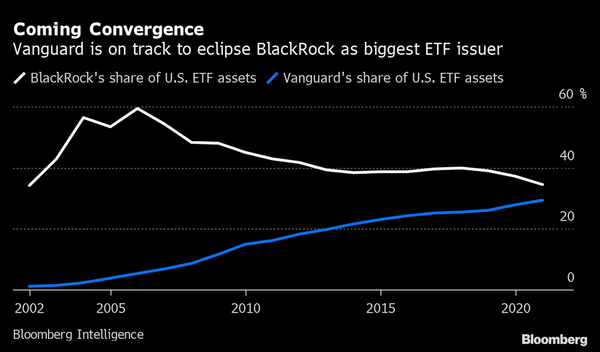David Miller, chief investment officer and co-founder of Strategy Shares ETFs, believes investors need to think beyond the style box when looking for the best ETFs.
"There's no reason, when you're building a portfolio, that you should be so concerned about style boxes," said Miller. Style boxes show how portfolios are built. They typically show how much of a portfolio is in large, small, value or growth stocks. "What you should really be concerned about is correlation and diversification."
He said that when most people talk about diversification, they mean owning a slew of securities. But that's usually too simplistic.
"The obvious problem is, if you own 500 stocks and the S&P 500 is down a lot, you're still down a lot," said Miller. "A place where diversification really works is when you diversify the source of the risk in your strategies, more so than the number of securities that you hold."
Aiming To Build The Best ETFs
Miller has been working to build the best ETFs during his career. Strategy Shares ETFs is just his latest venture. Miller has been involved in the creation of investment management products and some of the best ETFs and mutual funds since 2006.
His goal? Create nontraditional products that offer unique strategies for financial advisors and their clients.
Prior to Strategy Shares ETFs, Miller and co-founder Jerry Szilagyi, president and CEO, also launched two mutual fund firms, Catalyst Funds and Rational Funds. Combined with the firm's subadvisors and investment partners, total assets under management have grown to $45 billion as of Jan. 31. This includes some of the best mutual funds and ETFs under the umbrella.
Finding ETFs that help clients reach goals has been the firm's philosophy ever since its founding. Strategy Shares ETFs reached $1.6 billion in assets under management as of Jan. 31.
Miller holds an undergraduate degree from the University of Pennsylvania, Wharton School, and an MBA from the University of Michigan, Ross School of Business. He also worked at the equity derivatives group at UBS prior to founding his firm.
He spoke with Investor's Business Daily about the firm's strategy. And he discusses its five ETFs and how they fit into today's economic and market environment.
IBD: What's the mission and brief history behind your founding of Strategy Shares ETFs?
David Miller: We strive to provide innovative strategies to support financial advisors and their clients in meeting the investment challenges of an ever-changing global market environment.
In 2015 (we) acquired Huntington Asset Advisors from Huntington Bank. We re-branded the Huntington Strategy Shares ETF brand to Strategy Shares ETFs in September of 2015.
IBD: How is your firm different from other ETF issuers?
Miller: Every ETF in our lineup serves a very specific purpose that is not met by your typical style box or index ETF. One key focus is target distribution ETFs that are designed with clients' cash flow needs in mind. Our Gold Hedged Bond ETF is the only bond fund that hedges against inflation with a 1x exposure to the price of gold.
The Halt Climate Change ETF directly reverses global warming by funding 12,000 kilograms of carbon dioxide removal each year. And Newfound/ReSolve Robust Momentum ETF dynamically positions between equities and Treasurys depending upon market momentum.
IBD: Please describe the largest fund, its strategy, flows and performance?
Miller: The Strategy Shares Nasdaq 7HANDL Index ETF is a first-of-its-kind target distribution ETF designed to seek investment results that correlate generally, before fees and expenses, to the price and yield performance of the Nasdaq 7HANDL Index.
The index is split into two components. With a 50% allocation to fixed income and equity ETFs (the "Core Portfolio") and a 50% allocation to a "Dorsey Wright Explore Portfolio," a tactical allocation with U.S. fixed-income, U.S. blend, U.S. equity and U.S. alternative assets. (Those are) categories that have historically provided high levels of income.
The Nasdaq 7HANDL has adopted a policy to pay monthly distributions on fund shares at a target rate that represents an annualized payout of approximately 7% on the fund's per-share net asset value on the date of a distribution's declaration. All or a portion of a distribution may consist of a return of capital from the original investment and the distribution rate may be modified at any time.
HNDL raised $1.41 billion over the past year and $183.2 million in January 2022. The three-year performance of the fund is 8.75% annualized which places it in the top decile of its Morningstar category and earns it a 5-star rating.
IBD: What about the other four ETFs: how is each different from comparable ETFs in the market?
Miller: There are many gold ETFs and there are many bond ETFs. However, GLDB is the only ETF that both earns a yield from bonds and provides a potential inflation hedge through a 1x exposure to the price of gold. The Nasdaq 5HANDL Index ETF is a lower volatility target version of the 7HNDL ETF that targets a 7% distribution yield.
NZRO invests in companies that are pursuing and end to climate change and offsets carbon emissions ... through our contract with ClimeWorks.
ROMO uses a quantitative, rules-based methodology to provide exposure to broad U.S., international, and emerging equity indexes to the extent that equity indexes are exhibiting positive momentum relative to U.S. Treasury indexes. The Index will include U.S. Treasury exposure when equities exhibit negative momentum and trend following characteristics versus the U.S. Treasury markets.
IBD: You also have mutual funds, so what drives your decision to rather launch an ETF vs. a mutual fund?
Miller: We launch ETFs based on an evaluation of unmet needs for investors in the marketplace. When we identify a pain point that cannot be met by existing products that effects a broad class of investors that creates the drive for us to launch a new product. Our decision to launch an ETF versus a mutual fund is driven by the style of the strategy and how well the underlying assets held by a fund match the dynamics of the product wrapper.
IBD: What is your outlook for 2022 and beyond?
Miller: The market for 2022 is characterized by the Federal Reserve grappling with the best way to confront inflation without stifling the growth of the economy. It will be a year where the markets seek an equilibrium and balance between growth and value.
IBD: What are the major risks for investors in today's markets and how can they best navigate them?
Miller: The two primary risks that investors are confronting in our current market are the dual impact of rising interest rates combined with inflationary pressure. Both of these factors serve as a risk to fixed income investors that take material duration risk. However, equities have the potential to do well as interest rates rise and inflation pushes up the price of goods and services that businesses sell.
IBD: What is your message to investors today?
Miller: Investors need to adjust their expectations for an environment that is not consistent with the last 30 years of low inflation and low interest rates.










